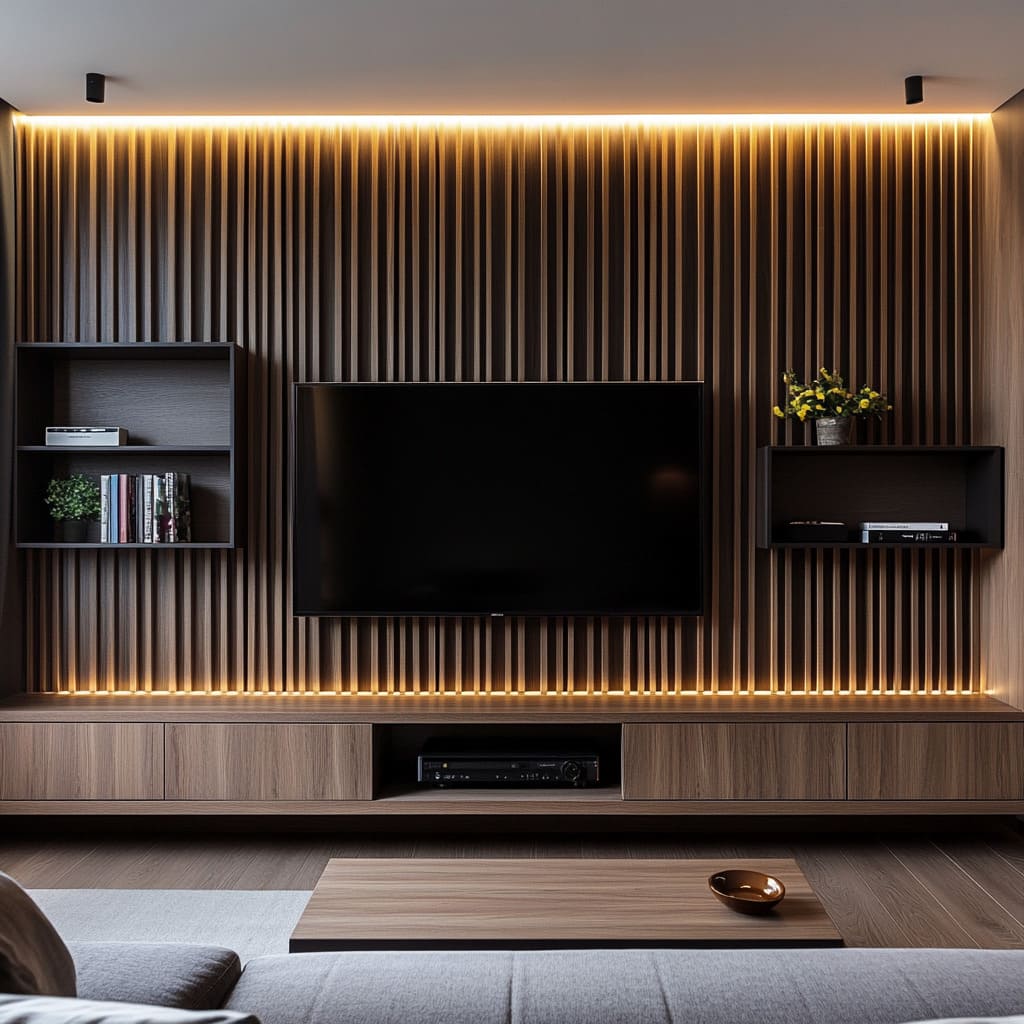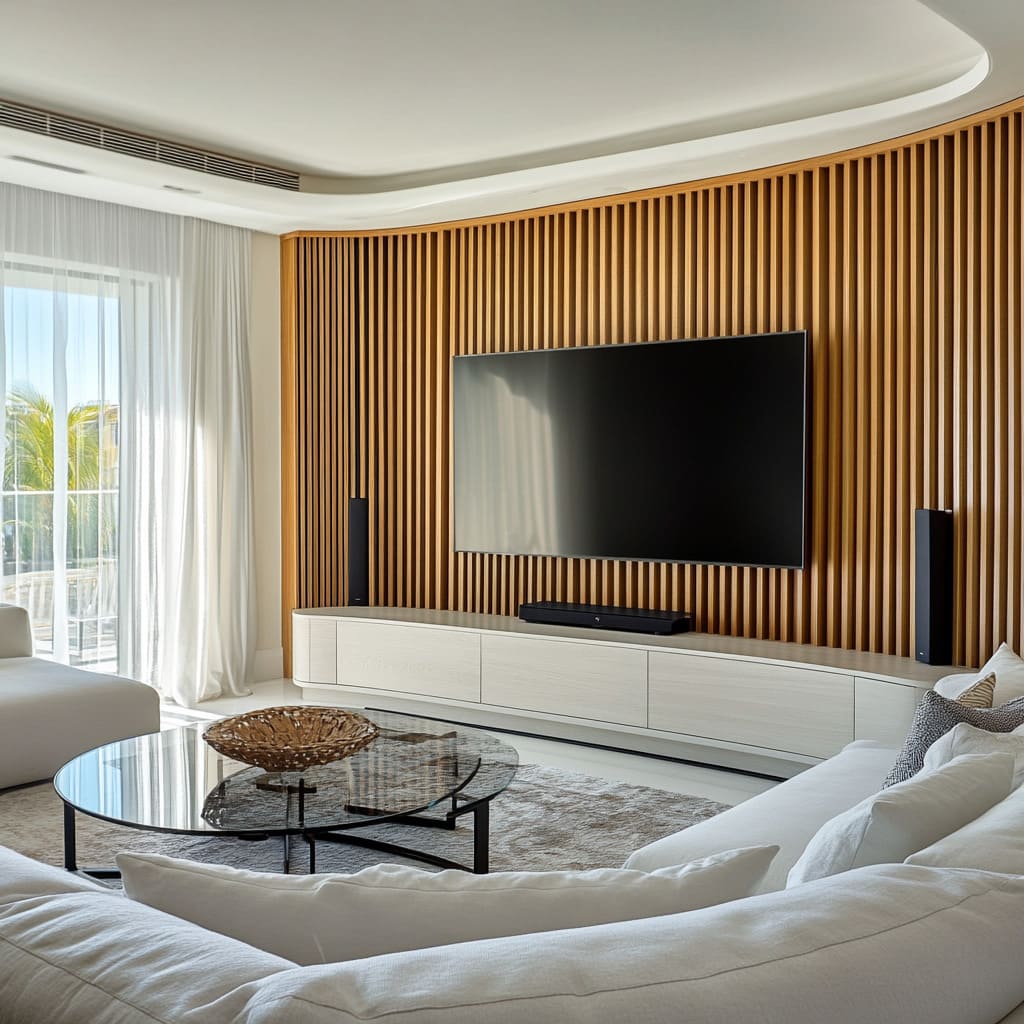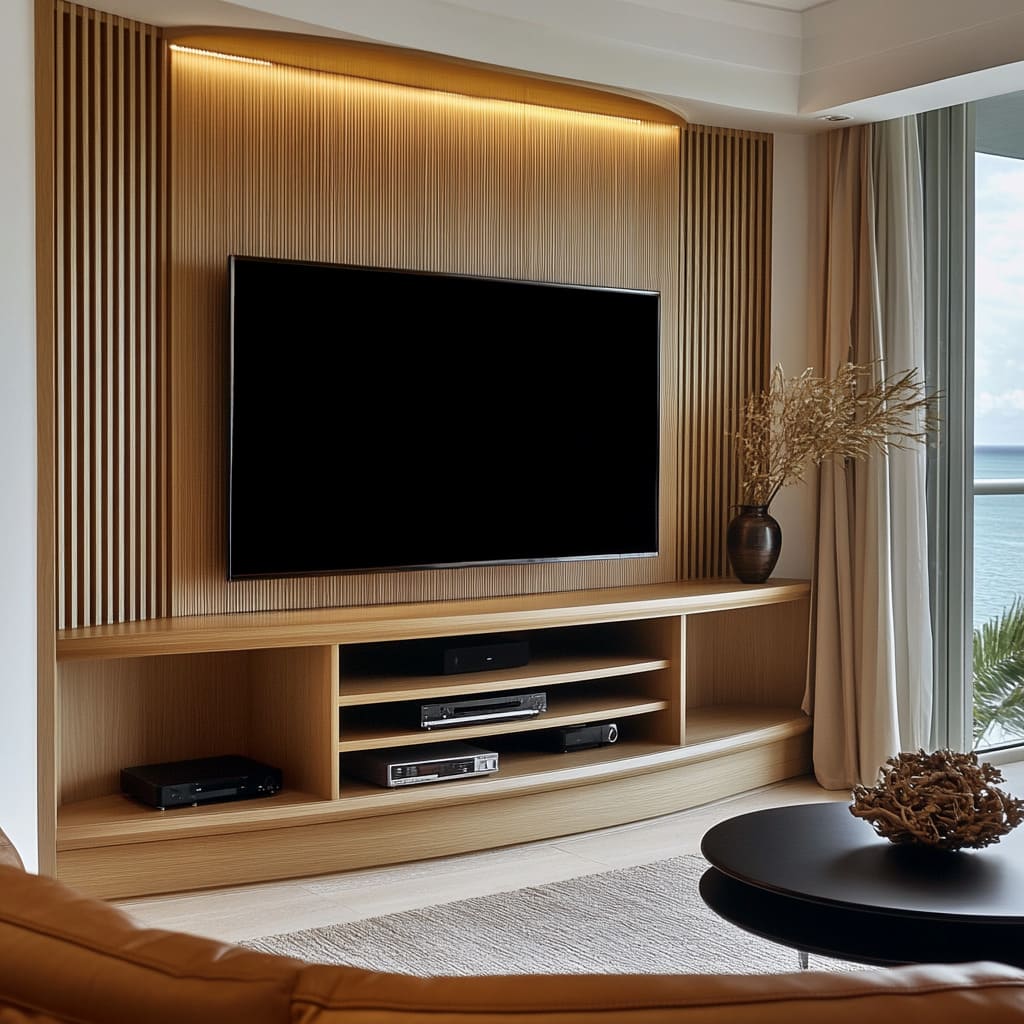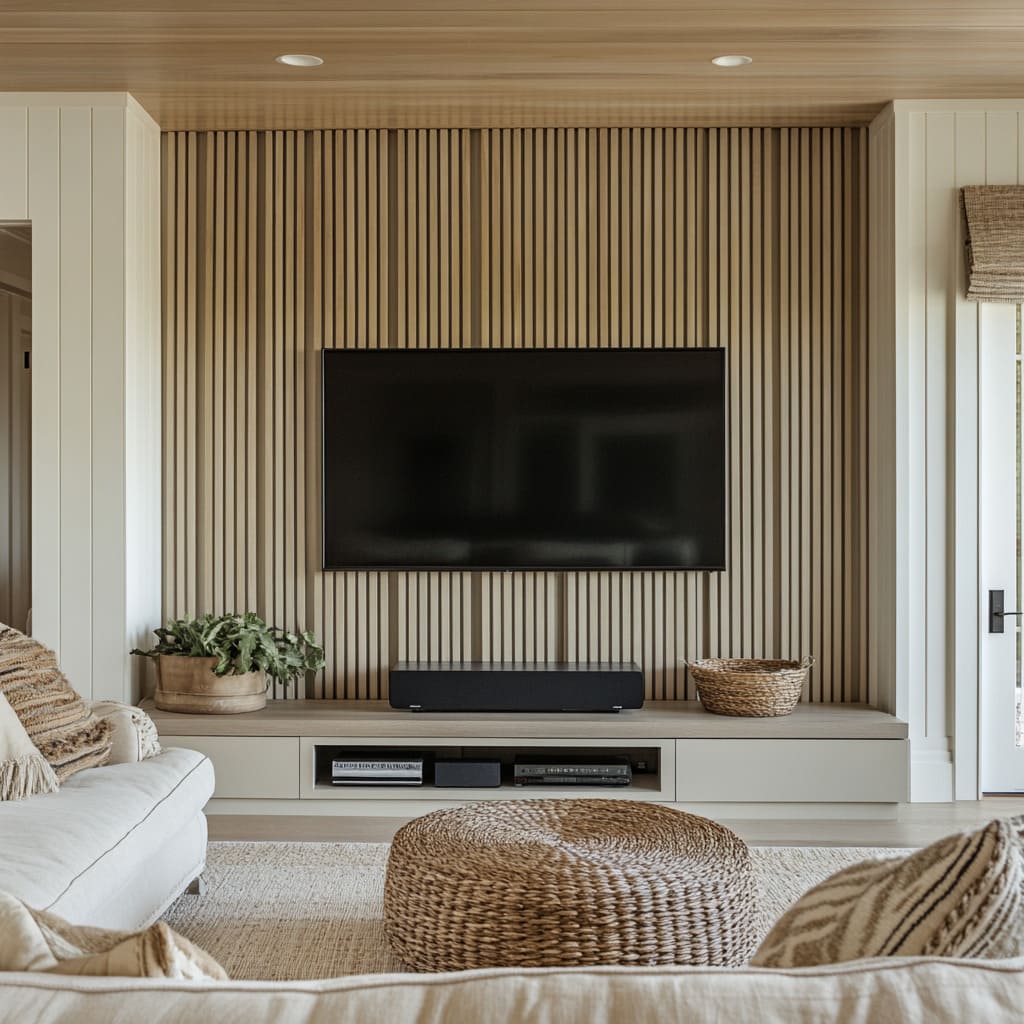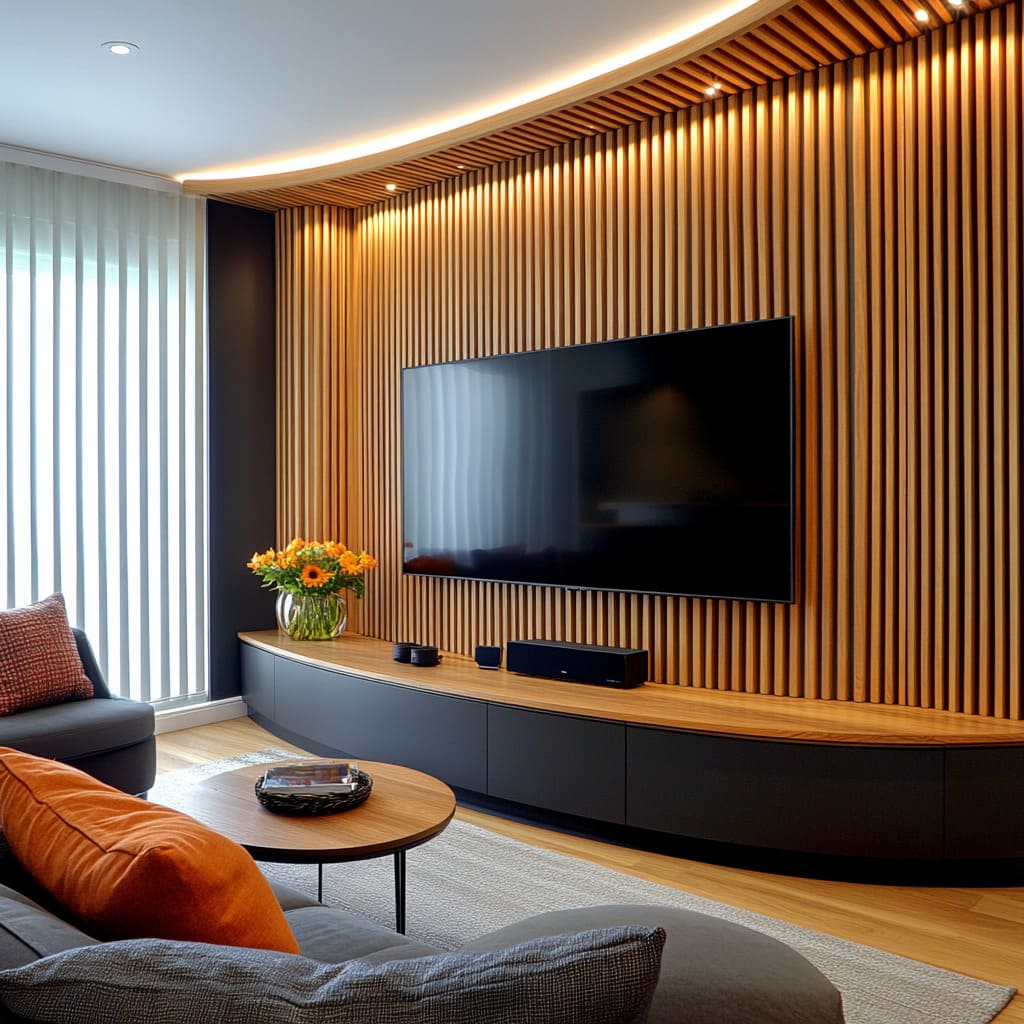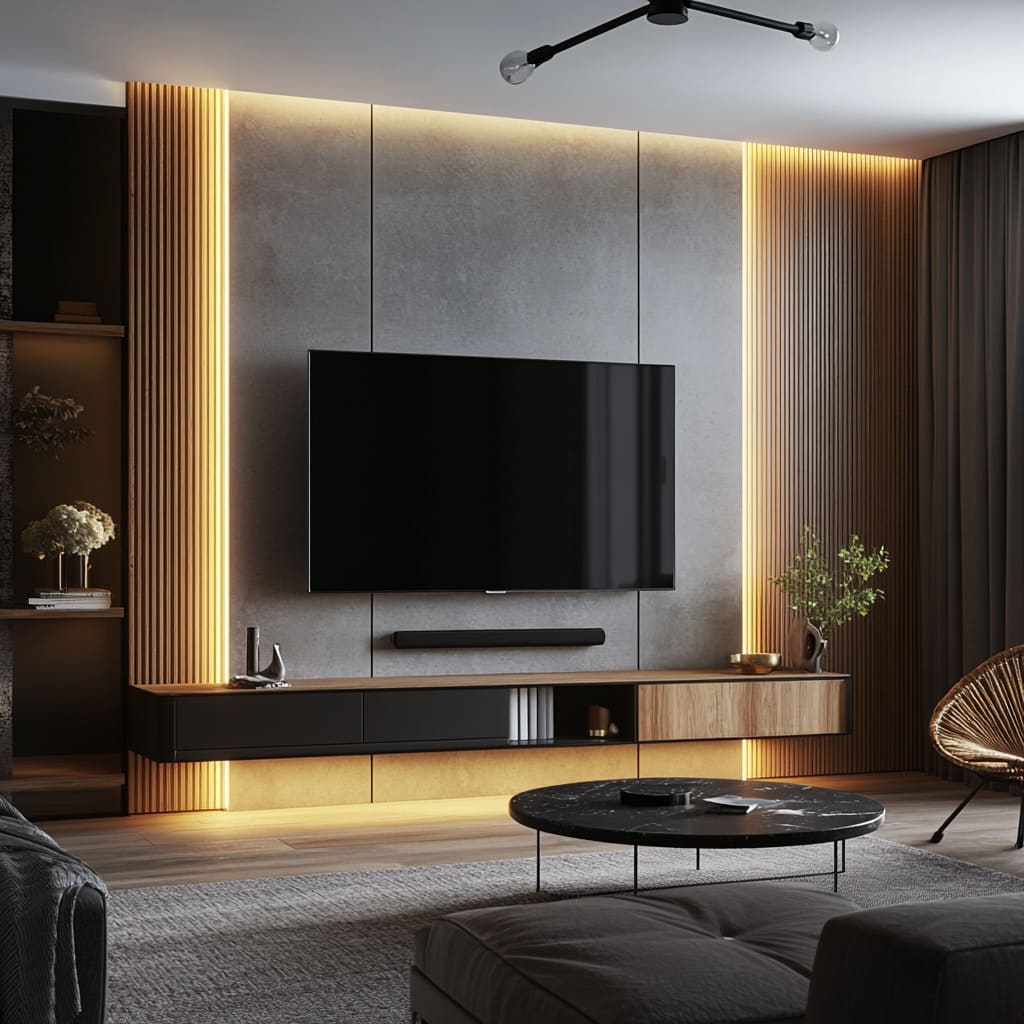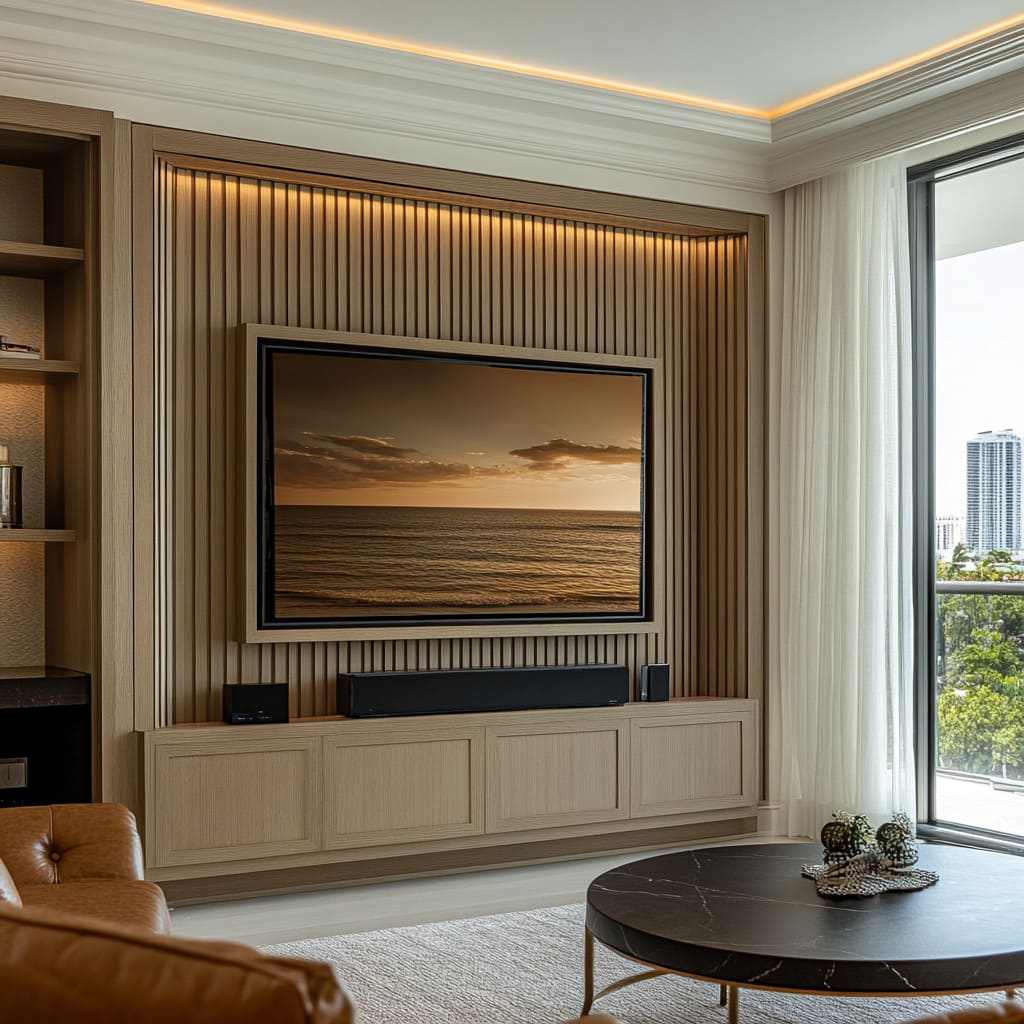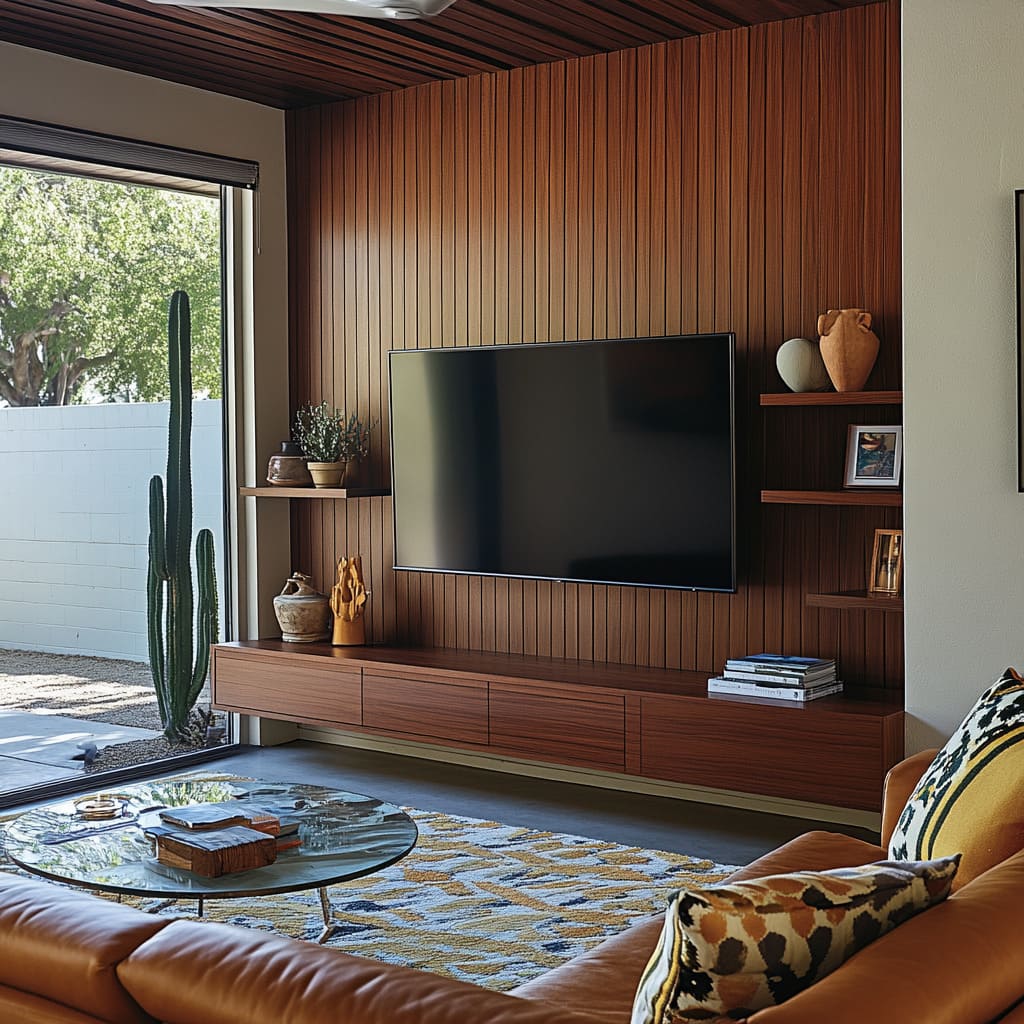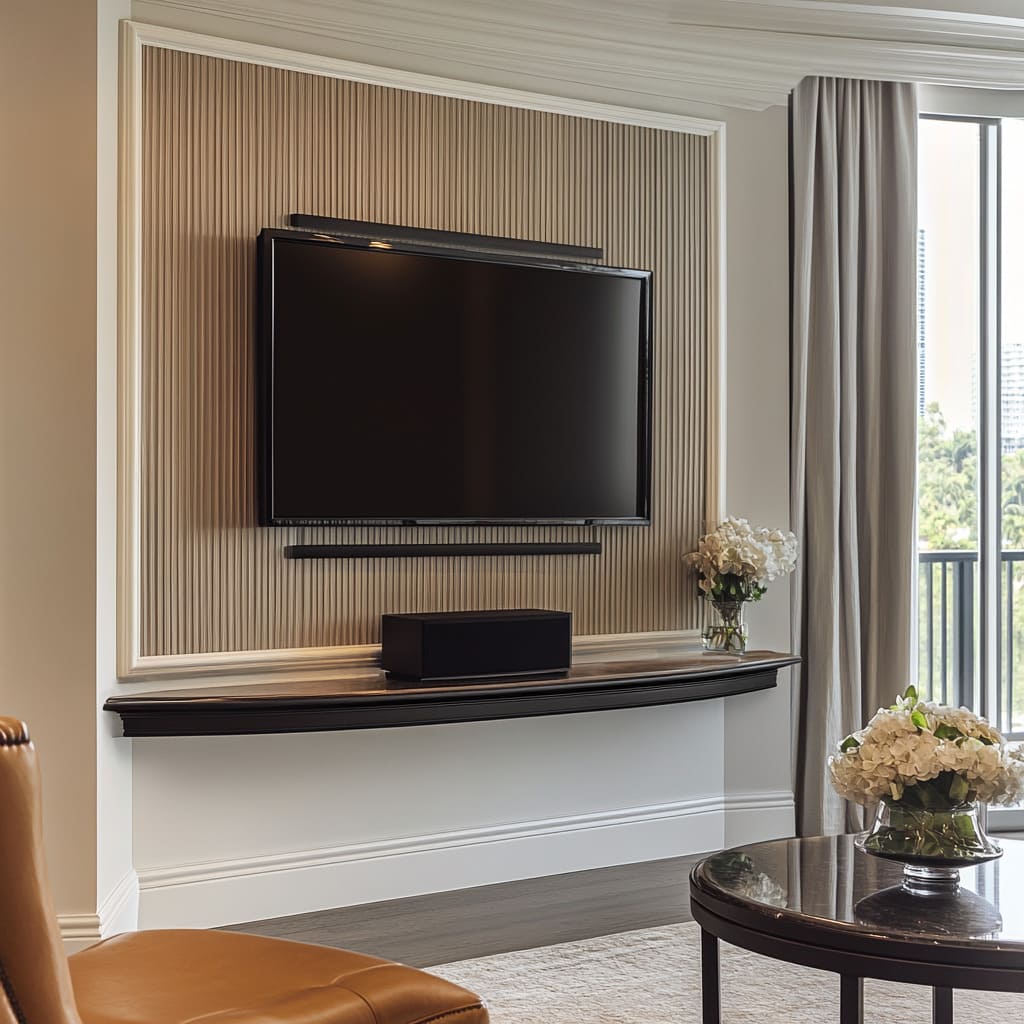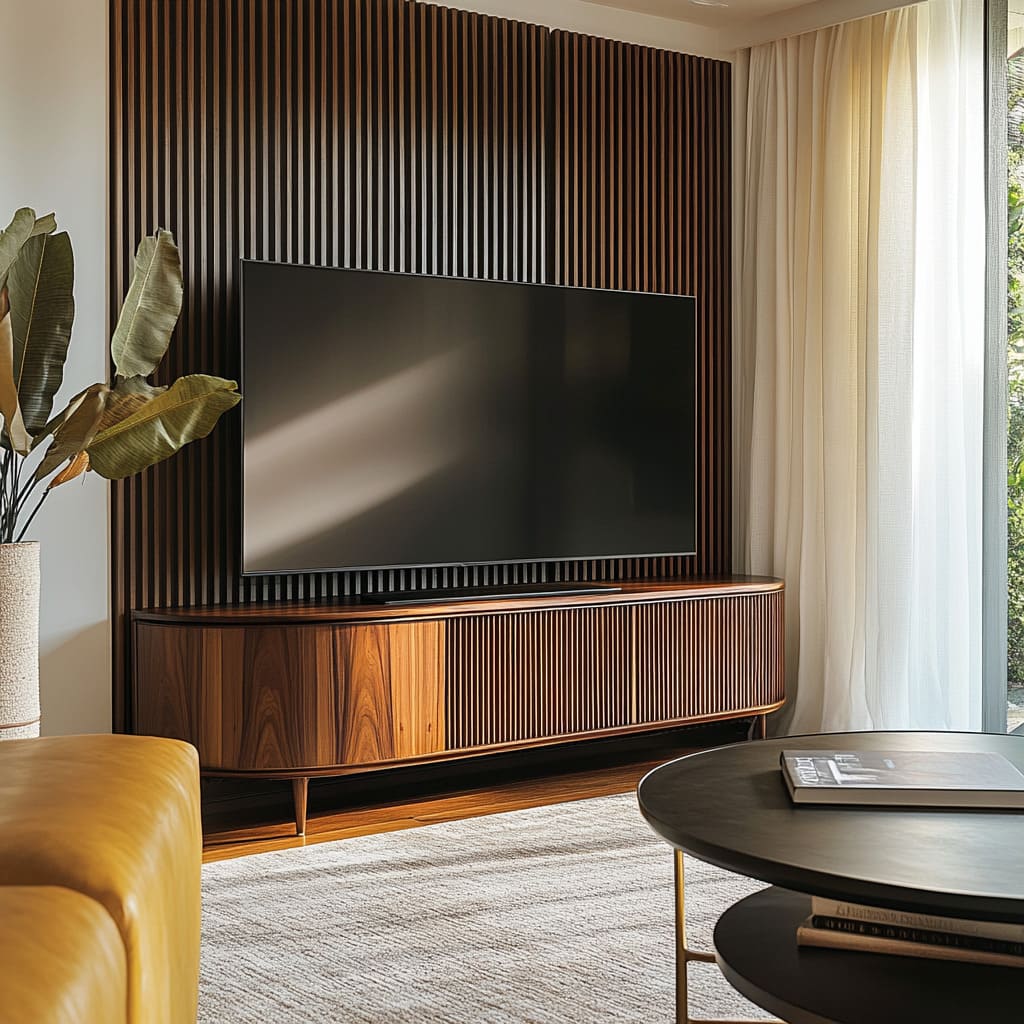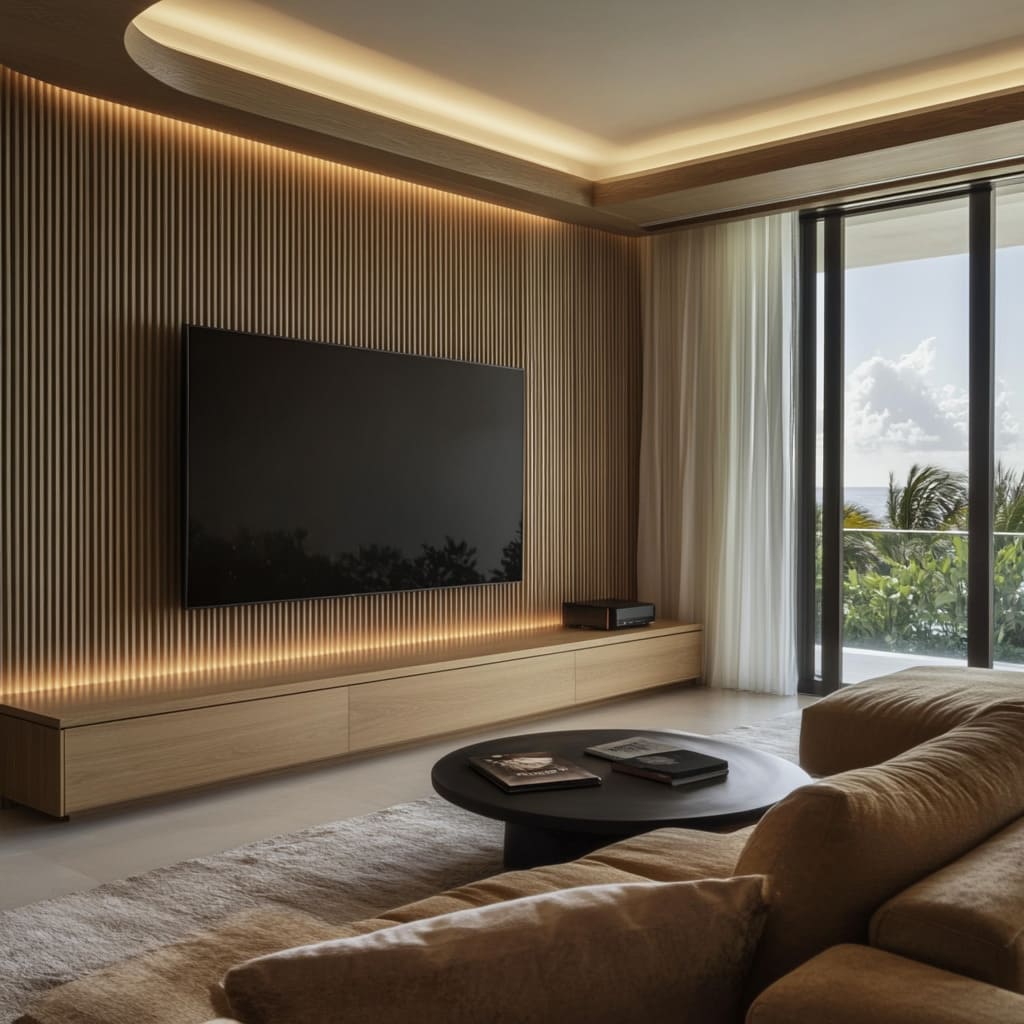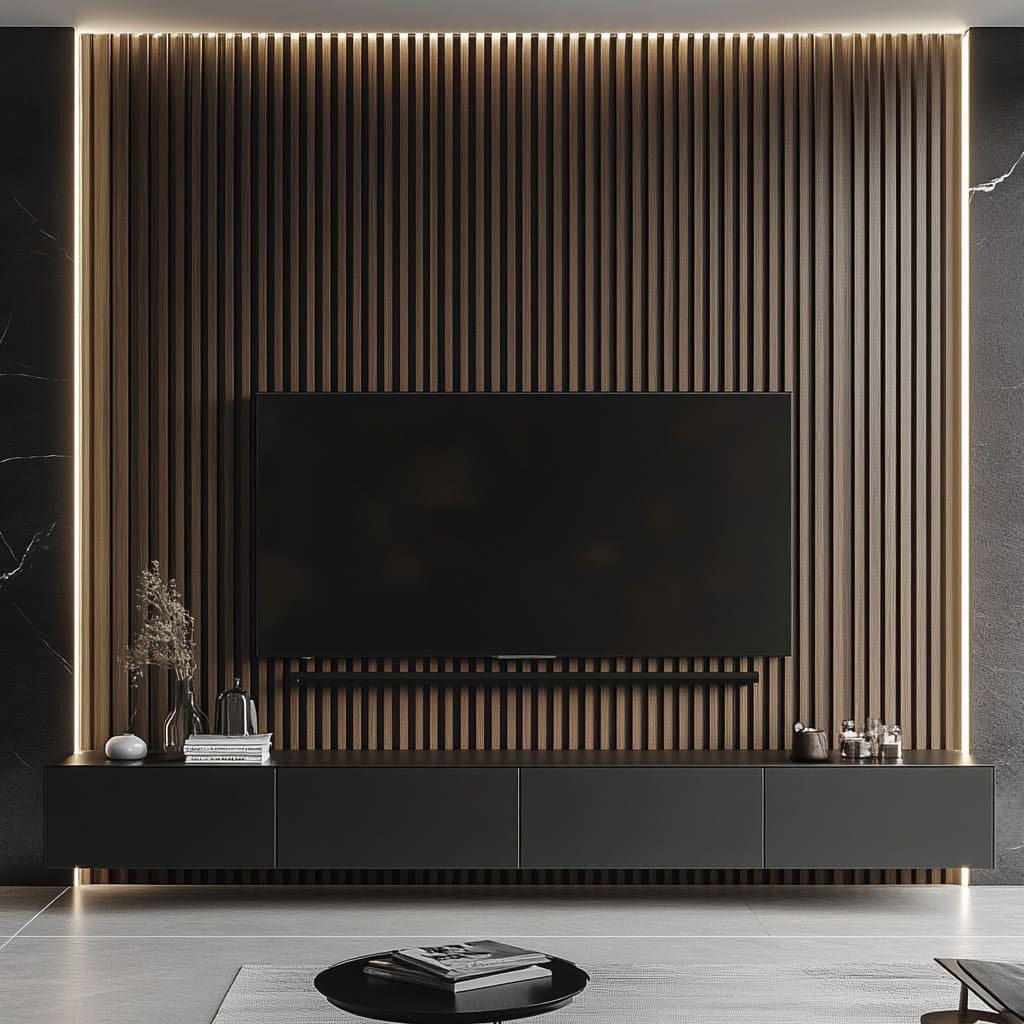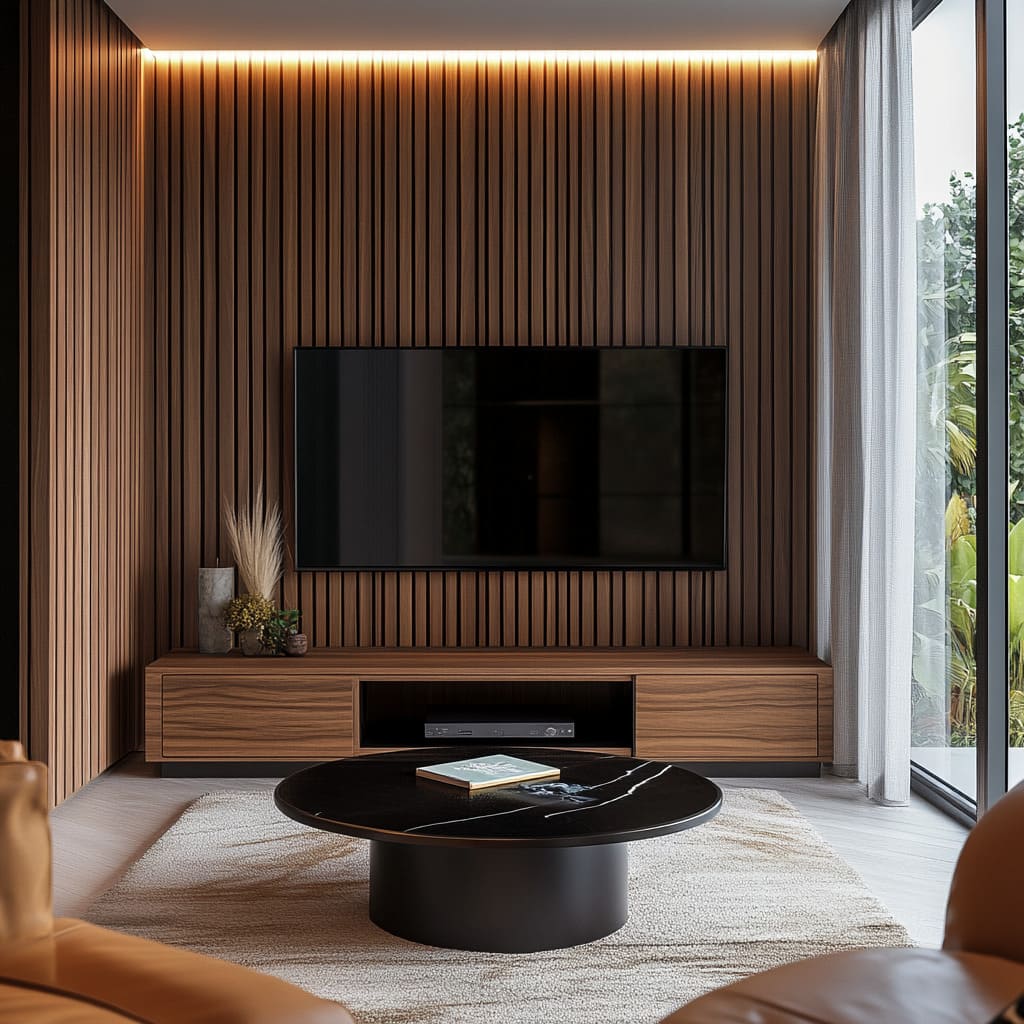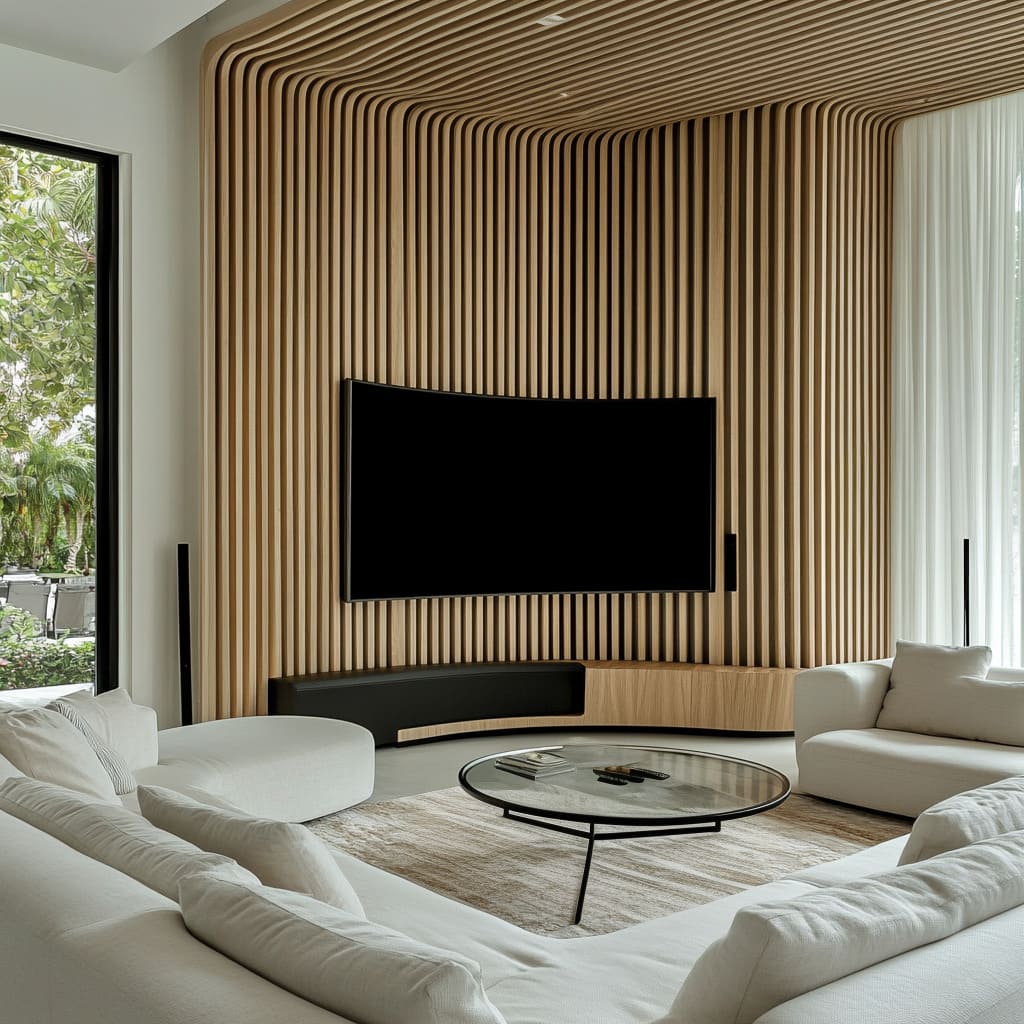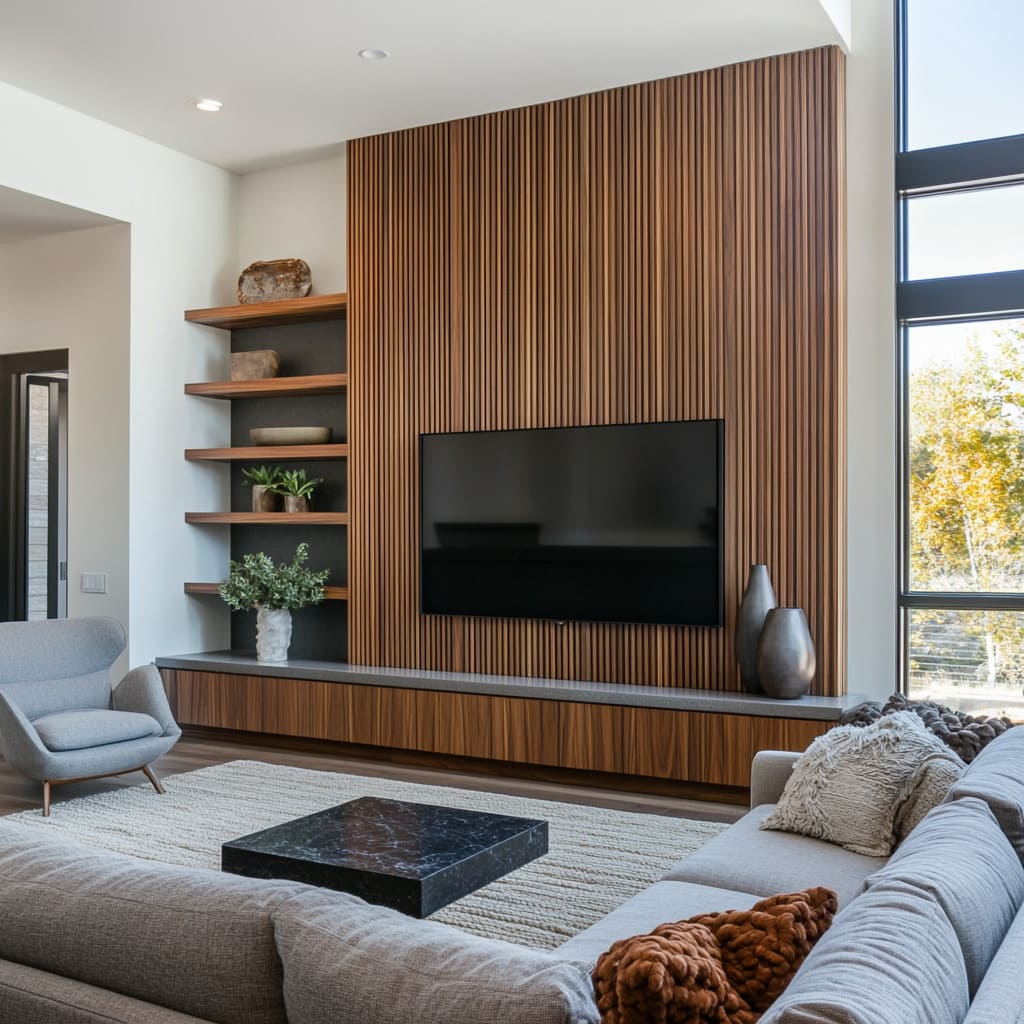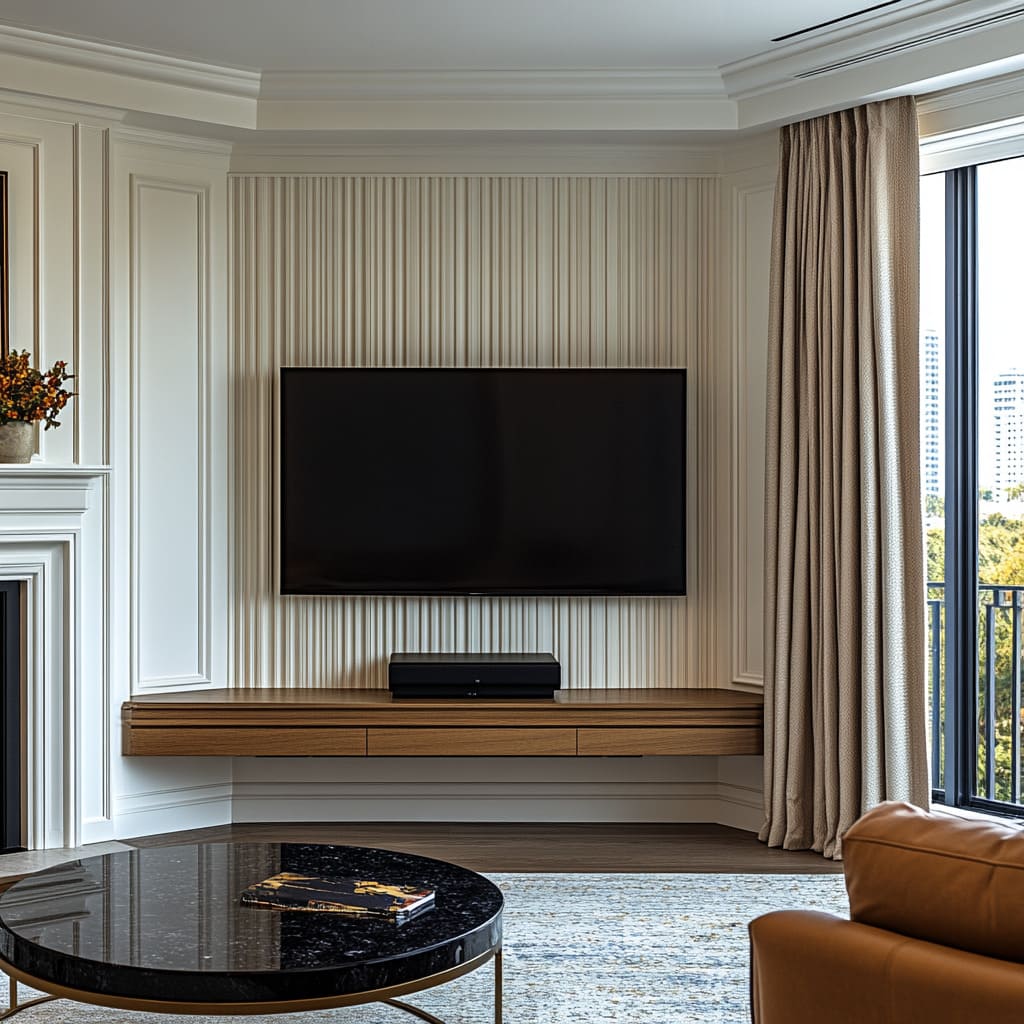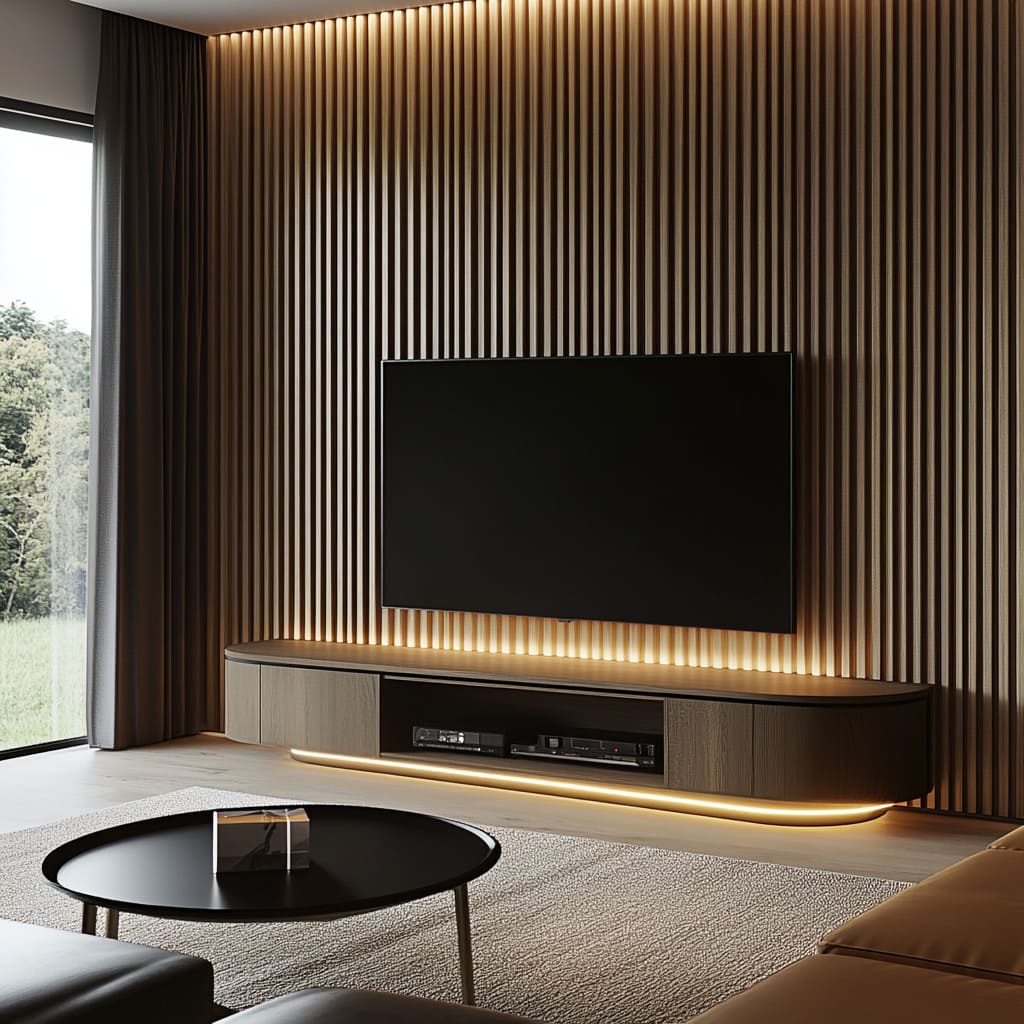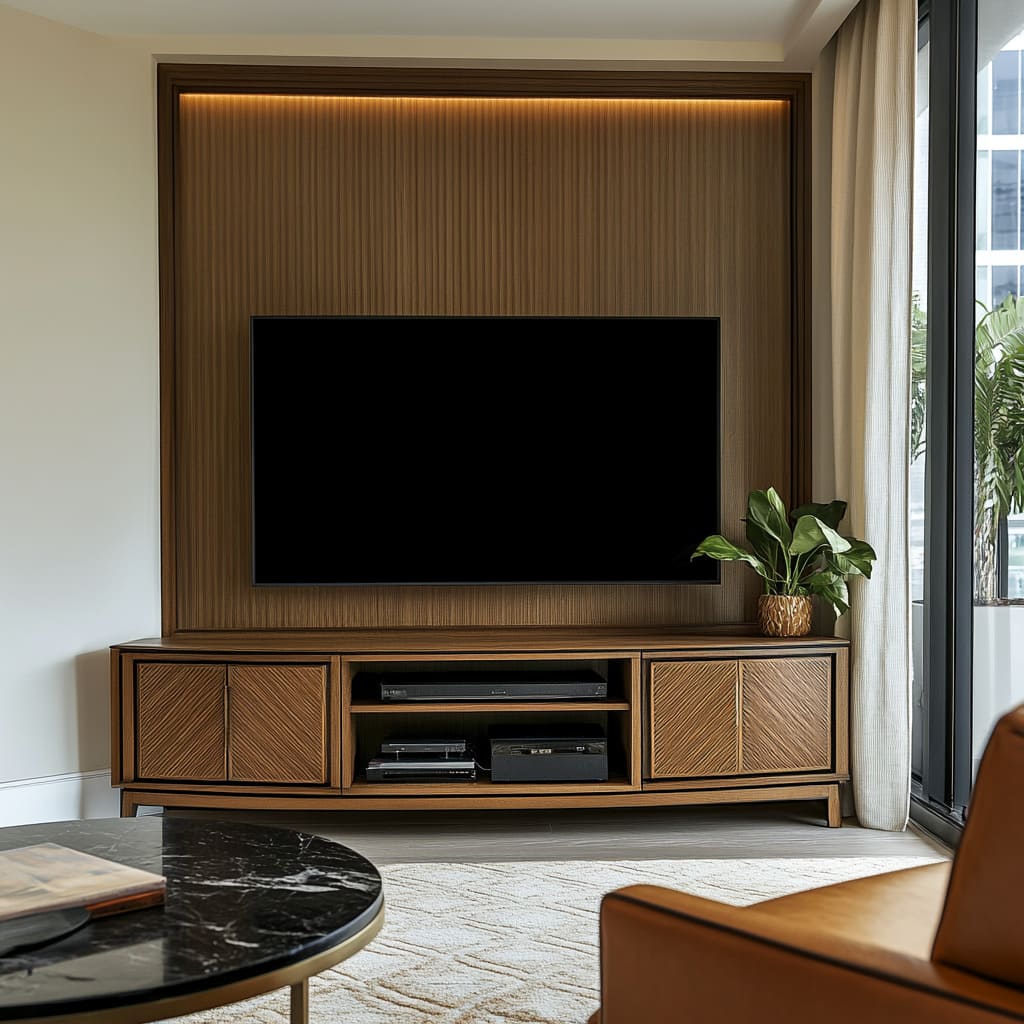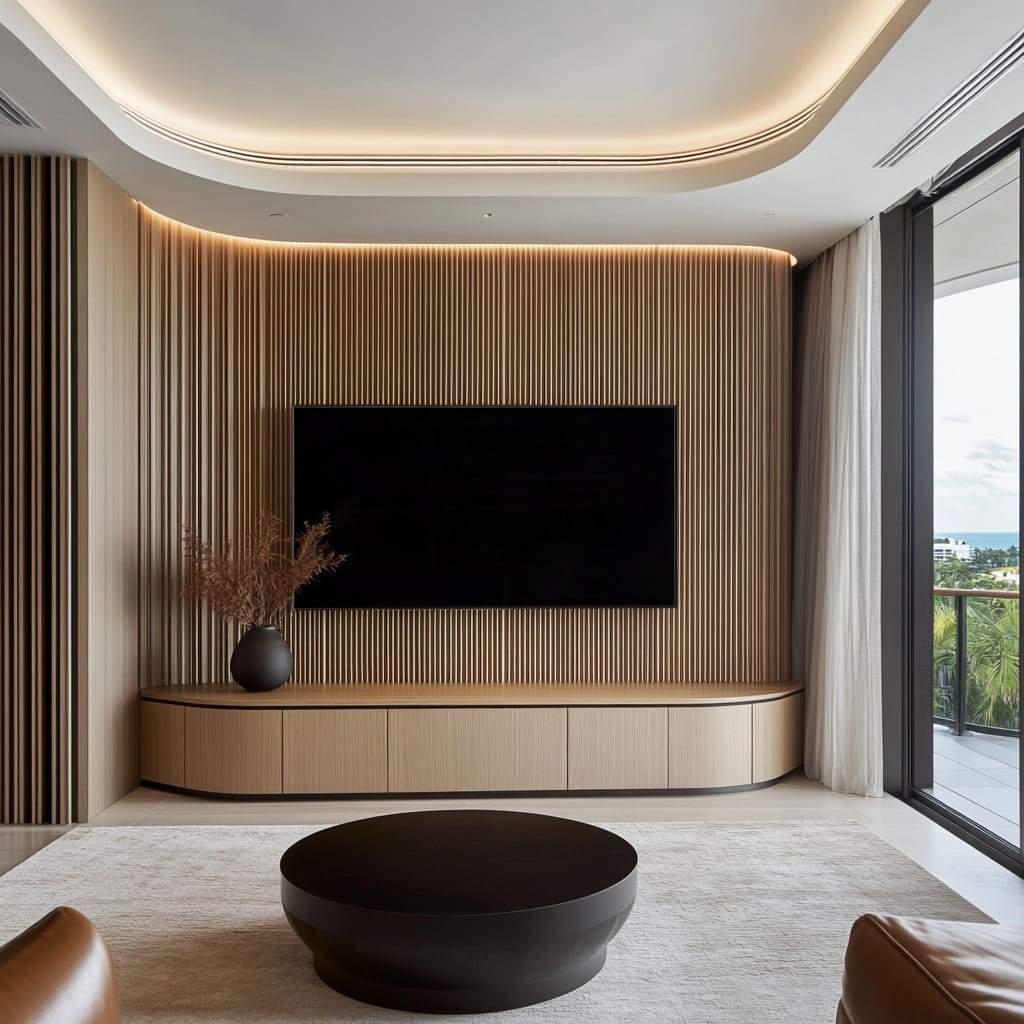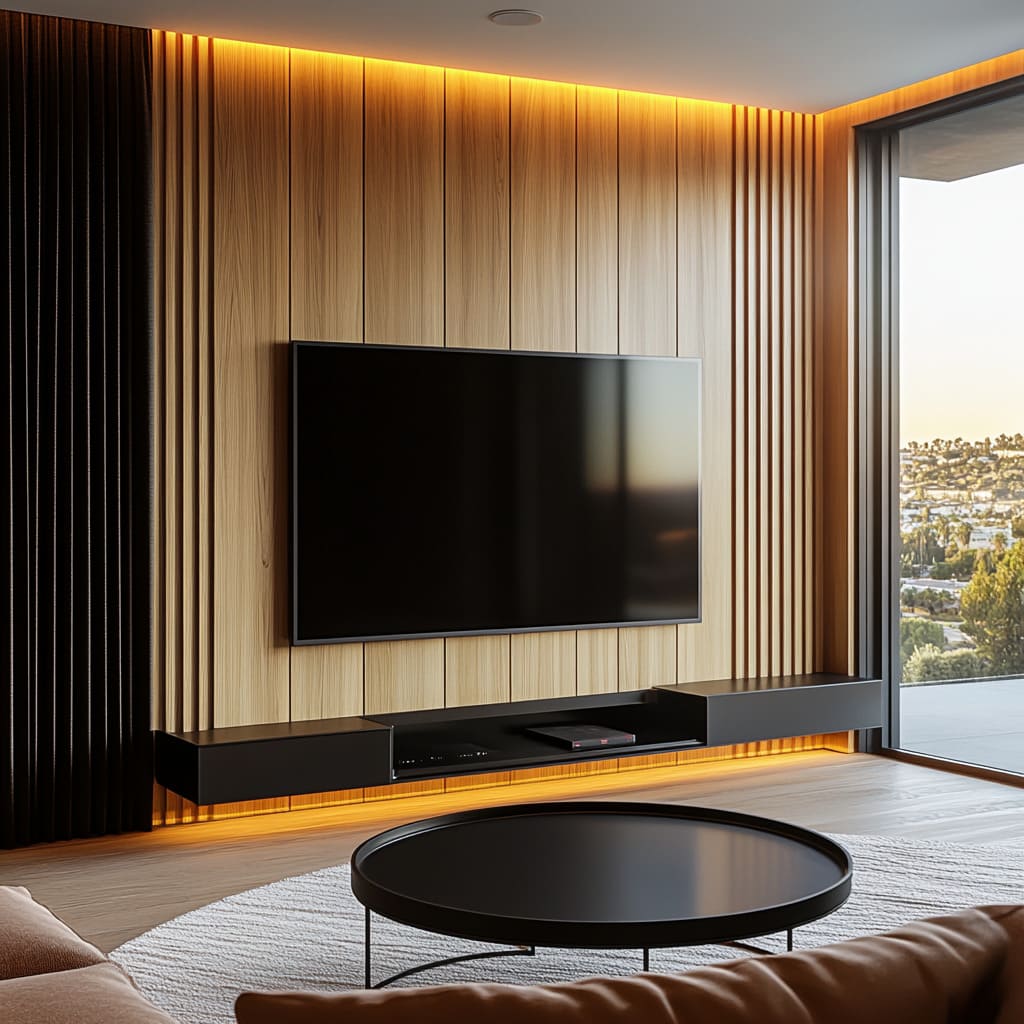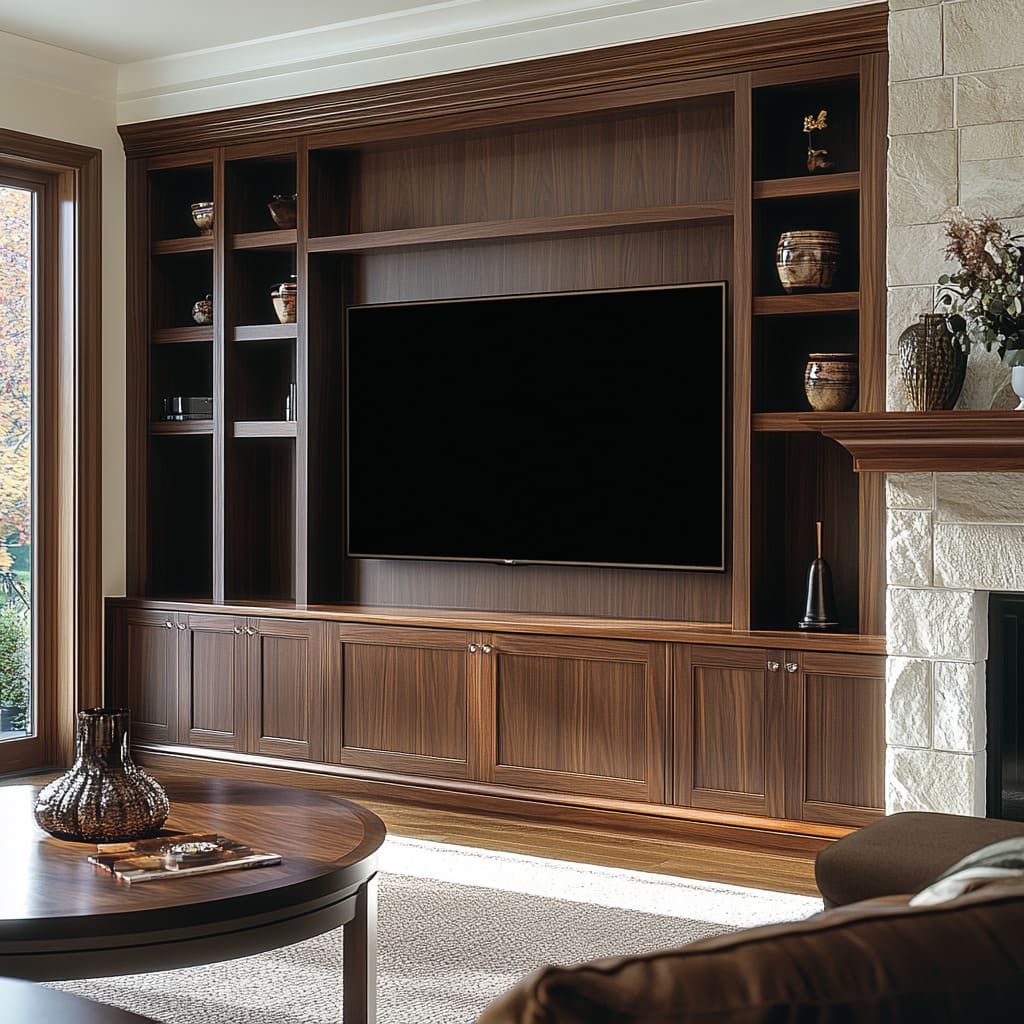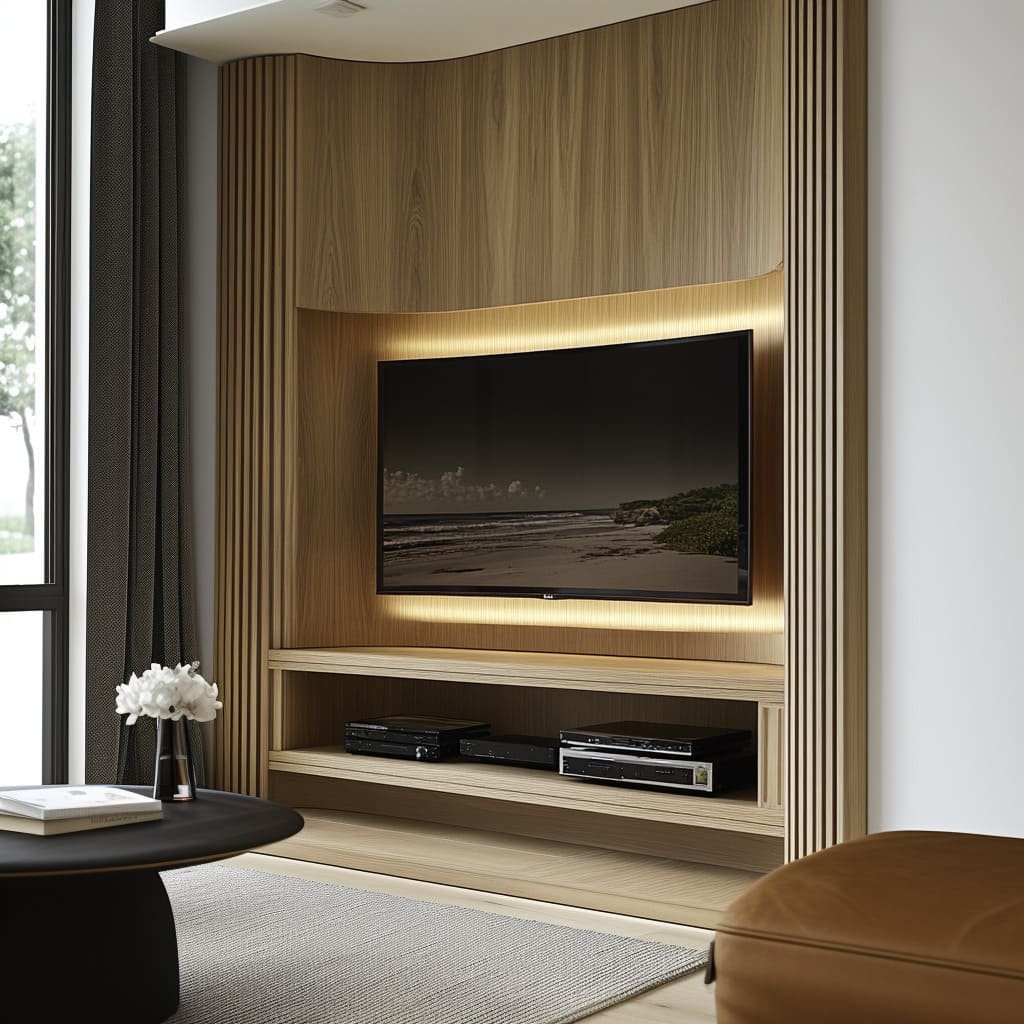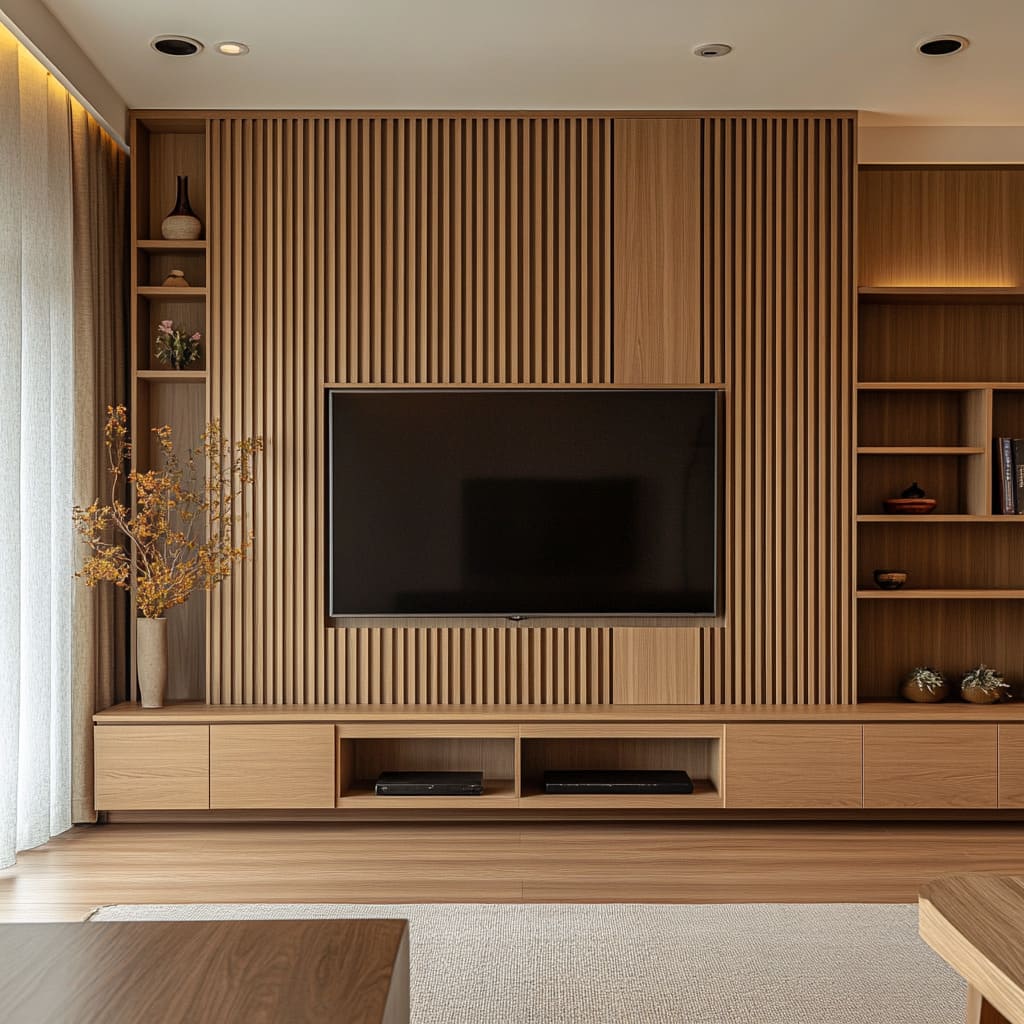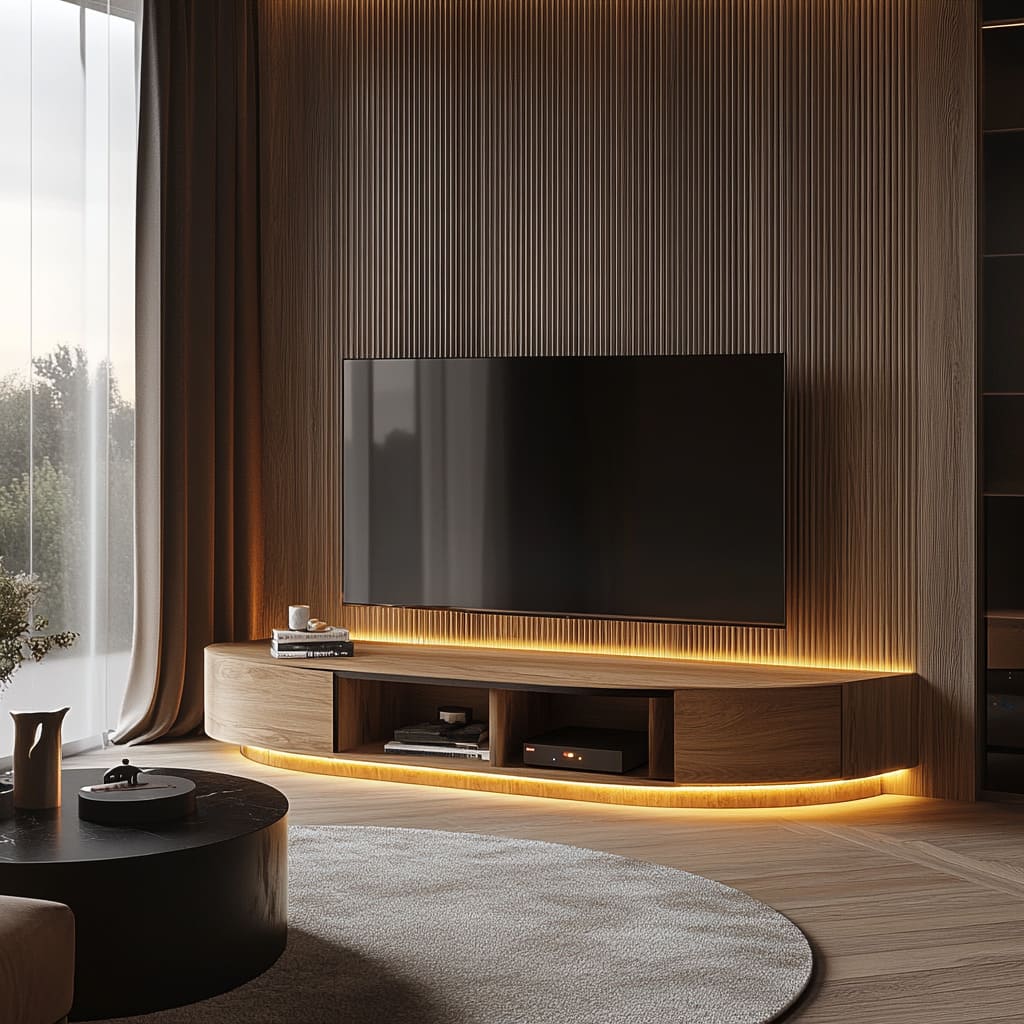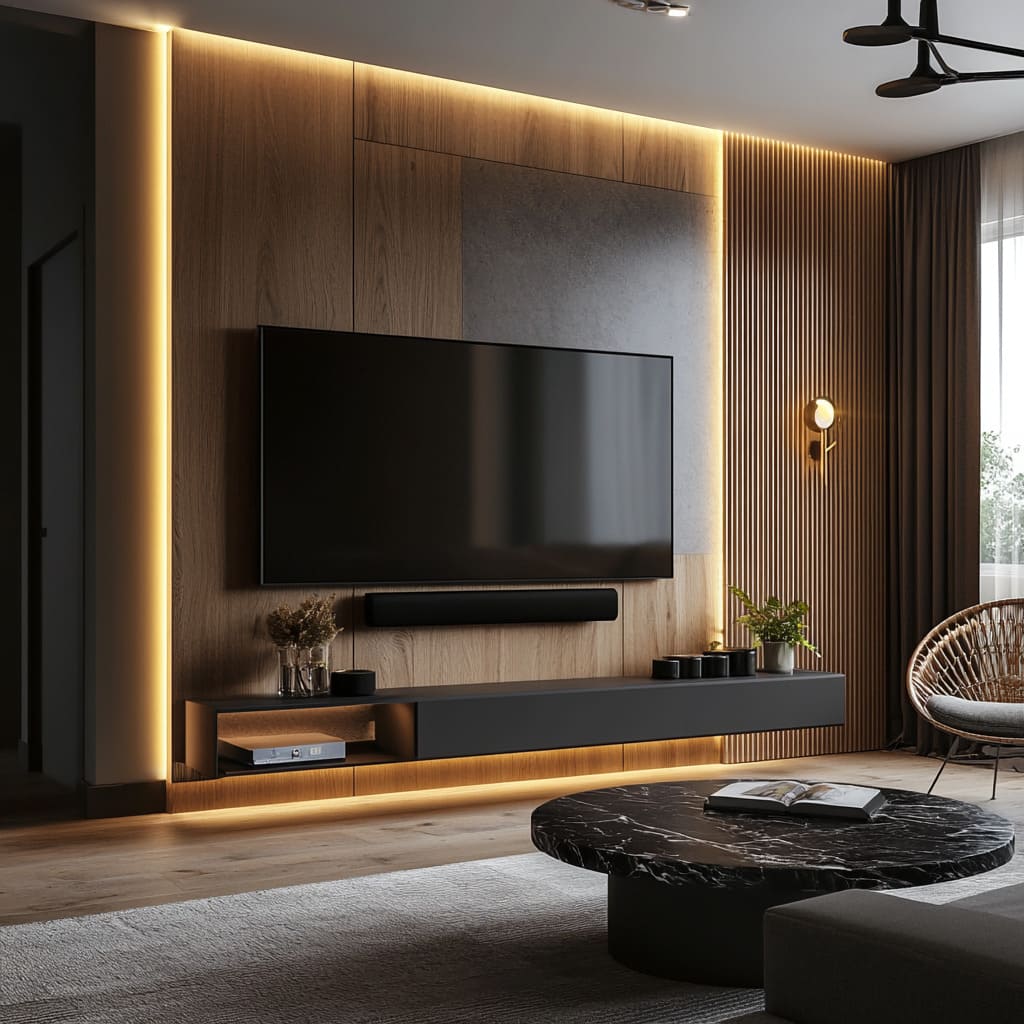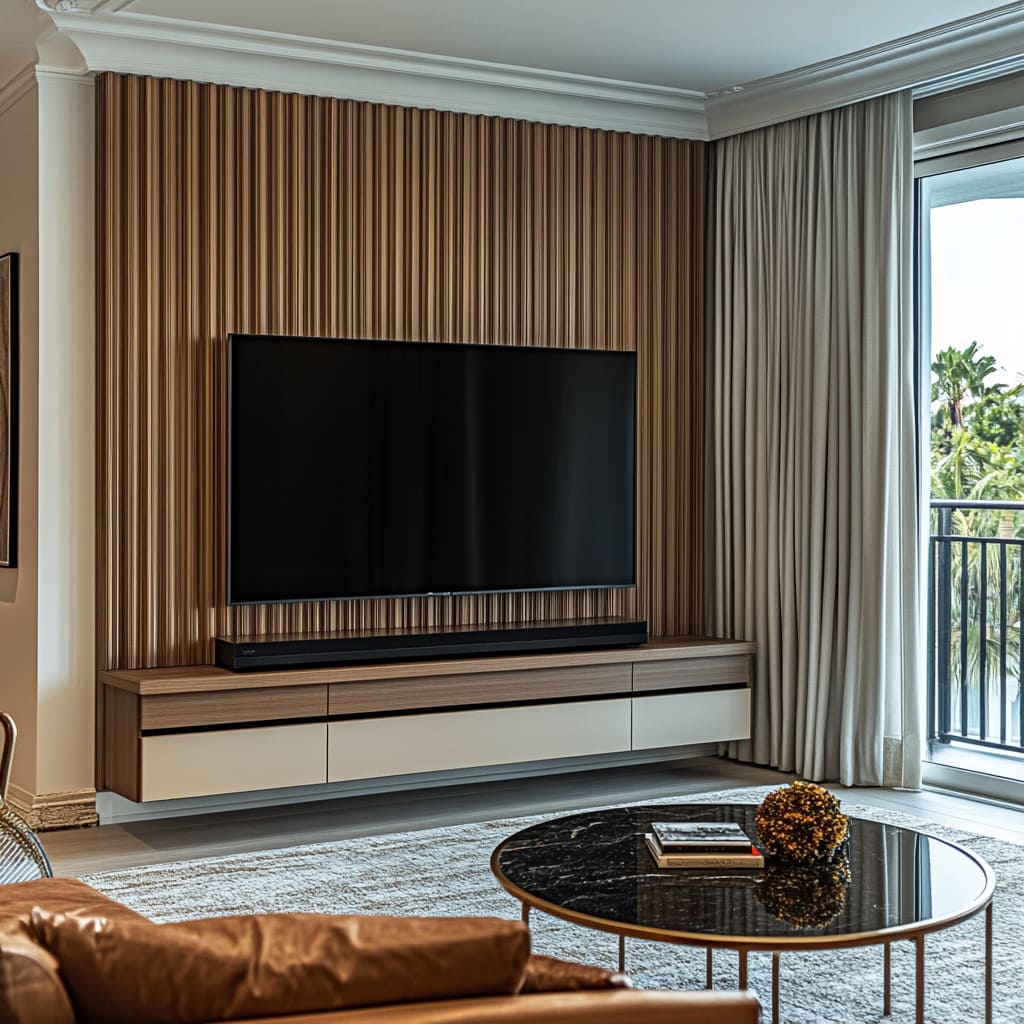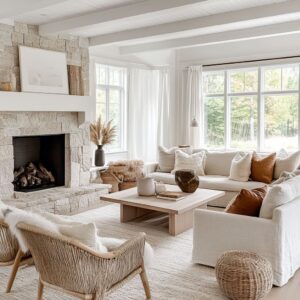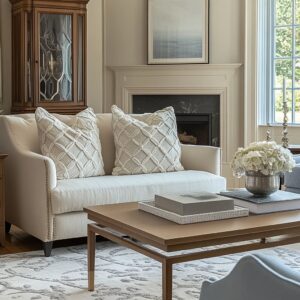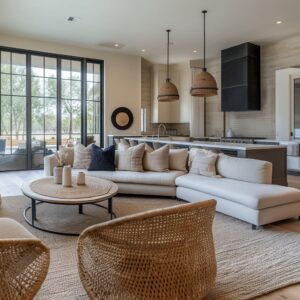A well-designed TV wall can do much more than just hold a screen—it shapes the entire atmosphere of a room. Slatted designs bring in texture, depth, and a sense of structure, making the TV area feel intentional rather than an afterthought.
Whether you’re looking for a sleek modern finish or something warmer and more organic, there’s no shortage of TV slat wall ideas that blend style with functionality.
From vertical panels that emphasize height to curved installations that soften sharp edges, slats provide endless possibilities for customization. Thoughtfully integrated lighting can enhance the wood’s texture, while hidden storage solutions help maintain a clutter-free space.
Whether paired with natural stone, matte black surfaces, or built-in shelving, the right combination of materials and layout can make the TV wall a focal point that enhances the entire living room. In this guide, we’ll break down the key design strategies behind slatted TV walls, helping you choose an approach that suits your space.
Whether you prefer a bold statement or a more subtle integration, the right design will ensure that your TV wall doesn’t just serve a purpose—it becomes an essential part of your home’s style.
Emphasizing Verticality and the Play of Shadows
A slats TV wall isn’t just about aesthetics—it plays a key role in shaping how light moves across the room and how spacious the space feels. One of the strongest visual tricks in interior design is verticality, and slatted panels take full advantage of this.
By extending from floor to ceiling, they naturally guide the eye upward, making any living room feel taller and more structured. This is particularly valuable in homes with standard or lower ceilings, where architectural features are limited but a sense of openness is still needed.
The spacing between slats isn’t just a matter of symmetry—it’s a design tool that interacts with both natural and artificial light. Throughout the day, sunlight filtering through the slats creates soft, shifting shadows that change with the angle of light, almost like an evolving pattern on the wall.
At night, integrated lighting behind or along the edges of the panels enhances this effect, adding subtle dimension without overwhelming the space.
If you’re looking to create this effect in your own living room, choosing the right wood tone and spacing is key. Lighter woods, such as oak or ash, work well in smaller rooms where the goal is to enhance height, while richer, deeper finishes can make a larger space feel more intimate.
Adding soft LED lighting at the edges of the slats helps define their depth, ensuring they don’t blend into the background but instead become a striking focal point. Whether you’re designing a modern, minimalist space or something with a more layered, textural feel, slatted walls bring an architectural quality that goes beyond a simple TV backdrop.
They create rhythm, balance, and a sense of movement that evolves throughout the day—turning the act of watching TV into an experience framed by thoughtful design.
Curved Forms for a Softer, More Inviting Space
Not all walls need to be flat, and a little curvature can go a long way in transforming a rigid, boxy layout into something more fluid and welcoming. Curved slat walls add movement to an interior, making them a perfect contrast to the sharp angles of furniture, windows, and structural elements.
Instead of feeling rigid and formal, a gentle arc draws the eye naturally, creating a sense of flow that can make a space feel more relaxed and harmonious. For living rooms that feel a little too structured, incorporating a curved design—whether through a rounded TV wall, softly bending slats, or a floating console with smooth edges—can make a noticeable difference.
This is especially useful in open-plan homes where straight lines dominate. A curved wall feature acts almost like a sculptural element, breaking the monotony of flat panels and adding a custom-built quality that feels intentional rather than purely functional.
One of the most effective ways to introduce this approach is by using wood slats behind TV setups that follow a curved contour. This technique allows the slats to create a continuous, wave-like effect, softening the presence of the screen and making the entire media wall feel more integrated with the room.
Pairing this with a floating console that mirrors the curvature reinforces the organic feel, ensuring the design flows as a whole rather than looking like separate components forced together. The beauty of curved details is that they work across various styles—from minimalist spaces that need a gentle architectural touch to more eclectic interiors where layered shapes bring depth.
If you’re working with a smaller living room, a subtle curve can even make the space feel more open by guiding movement more naturally. Whether you’re designing from scratch or updating an existing layout, curved slats add a layer of refinement that feels effortlessly modern.
Shelving and Hidden Storage That Blend Seamlessly
A well-designed TV wall isn’t just about aesthetics—it should be functional too. Many modern interiors incorporate shelving and concealed storage into slatted designs, ensuring that everything from media devices to decorative accents has a designated place without disrupting the clean, structured look.
By integrating open and hidden elements within TV wall slats, it’s possible to create a space that feels intentional rather than cluttered. One of the smartest ways to handle storage is through concealed compartments that sit flush with the wood paneling.
These hidden sections allow remotes, gaming consoles, or even extra cables to stay out of sight while maintaining easy access when needed. If a more open look is preferred, floating shelves inserted between slats can showcase books, ceramics, or greenery without making the wall feel overly busy.
The trick lies in using matching finishes so that storage elements feel like a natural extension of the design rather than a separate addition.
Before finalizing a setup, consider how much storage is truly necessary. If minimal electronics are involved, a streamlined floating console or a few open shelves might be enough.
For those with multiple devices or larger entertainment systems, a mix of hidden cabinets and visible shelving can balance function and aesthetics. Choosing the right materials also plays a role in keeping everything cohesive.
Whether using natural wood tones, deep-stained finishes, or a combination of matte black and warm oak, maintaining consistency across shelves, cabinets, and slats ensures a seamless look. The goal is to keep storage functional while allowing the slatted texture to remain the standout feature.
Subtle Illumination and the Art of Layering
Lighting is one of the most overlooked elements in interior design, yet it plays a huge role in how a space feels. A well-lit slatted media wall does more than just highlight the texture of the wood—it enhances depth, warmth, and atmosphere.
Soft, indirect lighting can turn a simple TV wall into a striking focal point, making the space feel polished and inviting, even when the screen is off. One of the most effective ways to introduce lighting into slatted walls is by placing LED strips behind or along the edges of the panels.
This creates a soft glow that emphasizes the natural grain and spacing of the slats without overpowering the room. At night, this subtle backlighting can replace harsh overhead lights, allowing for a cozy and balanced ambiance.
For those incorporating shelving, recessed lighting within alcoves can highlight objects without adding clutter. A floating console beneath the TV can also benefit from under-lighting, helping it appear weightless while adding another layer of warmth.
Using a dimmer switch is a smart way to adjust brightness levels throughout the day—brighter settings for daytime functionality and a softer glow for relaxed evenings. The key is balance.
Too much lighting can make the space feel artificial, while too little can cause the details of the slats to get lost. With the right placement and intensity, illumination transforms a TV wall into something far more engaging, where light and shadow work together to add a dynamic quality to the room.
Thoughtful Material Combinations for a Striking TV Wall
A well-designed slatted wall doesn’t have to rely solely on wood to make an impact. The most compelling designs often feature a blend of materials that contrast and complement each other, creating depth and dimension.
Whether incorporating stone, metal, matte black finishes, or painted panels, the right combination can transform a simple installation into an architectural statement. If you’re looking for a bold, high-contrast effect, pairing light wood slats with deep, richly veined marble or dark matte panels can create a dramatic centerpiece.
The interplay between smooth and textured surfaces adds visual weight, making the TV wall a standout feature in the room. This works particularly well in modern and industrial-inspired interiors, where sharp contrasts enhance the overall aesthetic.
For a more understated, cohesive look, consider using materials that share a similar undertone. A warm-toned slat TV wall could incorporate soft beige or taupe stone, subtle concrete textures, or black elements that seamlessly blend with the slats rather than competing with them.
This approach keeps the focus on texture rather than bold color shifts, making the space feel refined and well-balanced. The key to mixing materials successfully is to ensure that each one plays a role without overpowering the others.
Whether you prefer a striking contrast or a soft transition, the right material choices will elevate your TV wall beyond a simple backdrop, turning it into a well-integrated design feature that enhances the entire living space.
Framing the Screen with a Thoughtful Approach
A TV should feel like a natural part of the room, not an awkward addition to an otherwise well-designed space. That’s why integrating the screen into the overall composition is key.
Whether recessed into a dedicated panel or framed as a feature, a well-planned wooden slat wall with a TV can make the display feel intentional rather than just mounted on a surface. One of the most effective techniques is recessing the screen within a slatted section, creating a flush, built-in look.
This not only minimizes glare but also reduces the visual dominance of the TV when it’s turned off. The surrounding slats add texture and warmth, preventing the wall from looking too flat or technical.
For those who prefer a more defined structure, a bold frame in the same wood finish as the slats can enhance the appearance of the TV, making it feel like a curated design element. Think of it as a modern gallery-style mount—where the television becomes part of the architecture rather than something separate from it.
This approach works particularly well in contemporary or minimalist interiors where clean lines and symmetry are important. Regardless of whether the goal is to conceal or highlight the screen, framing it properly ensures that it blends with the rest of the space rather than feeling like an afterthought.
A well-executed design will not only enhance the TV wall but also create a polished, cohesive atmosphere that makes every viewing experience feel more refined.
Extending Slats to the Ceiling and Beyond
A wood slat TV wall doesn’t have to stop at the edges—it can flow into the ceiling or wrap around corners, creating a more immersive and architecturally dynamic effect. This approach eliminates harsh visual breaks, allowing the slats to guide the eye smoothly through the space, making it feel more cohesive.
For homes with recessed ceilings or lowered soffits, extending slats upward can turn an ordinary ceiling into a standout feature. The transition feels intentional, giving the impression that the slats are an integral part of the room rather than just a decorative panel.
With subtle backlighting added along the edges, the effect can be even more dramatic, enhancing depth and texture without overwhelming the space.
In smaller rooms, a full wrap may feel too enclosed, but a partial extension—such as curving the slats slightly at the top or continuing them onto an adjacent wall—can soften hard angles and make the design feel more fluid. This is especially useful in open-plan spaces where different areas need to feel connected without being identical.
By thinking beyond the standard flat installation, slatted walls can become more than just a background for a TV. They can define the entire space, adding warmth, structure, and a custom-built feel that blends seamlessly with the rest of the room.
Balancing Colors and Accents for a Cohesive Look
A slat wall behind the TV can set the tone for an entire living room, but without the right color balance, it might either dominate the space or feel incomplete. This is where carefully chosen accent pieces come into play.
Small decor elements, from sculptural vases to textured cushions, can shift the overall feel of the room without taking away from the wood’s natural appeal. For those working with a darker slatted wall, lighter or metallic accents can introduce contrast, preventing the space from feeling too heavy.
A sleek coffee table with a reflective surface or a few warm-toned accessories can make the setup feel more dynamic. Vibrant details, such as deep green from houseplants or rust-colored ceramics, help break up the uniformity while adding personality.
In a more neutral scheme, the focus should be on textures rather than strong color contrasts. Woven baskets, linen-upholstered furniture, and natural stone pieces complement the warmth of the wood without competing for attention.
Even subtle variations in materials—like a matte black soundbar against rich walnut slats—can make a difference in how layered and inviting the design feels. The key is to let the slats remain the backdrop while using accent pieces to refine the composition.
Whether through soft textiles, decorative lighting, or curated objects, these small choices help shape a space that feels balanced, inviting, and visually complete.
Merging Traditional and Contemporary Styles Seamlessly
A wood slat wall behind the TV doesn’t have to belong strictly to one design era. Some of the most striking interiors blend classic and modern elements, resulting in a space that feels layered and timeless rather than tied to a single trend.
Whether incorporating traditional moldings, mid-century influences, or sleek contemporary finishes, the key is finding the right balance.
For homes with traditional architectural details, integrating slats doesn’t mean losing that character. One way to merge the two styles is by painting the slats to match existing trim or wainscoting.
This allows the texture to stand out while ensuring the transition between styles feels natural. Soft neutral shades or muted tones work best for maintaining an elegant and cohesive look.
On the other hand, if a mid-century feel is the goal, rich wood tones like walnut or teak can make all the difference. Pairing vertical slats with curved console edges, tapered furniture legs, and warm brass or black metal accents helps reinforce that distinctive aesthetic.
Floating shelves in a complementary wood finish can further connect the wall to other elements in the room. By thoughtfully combining different influences, a slatted TV wall can become a bridge between styles, adding texture and depth while respecting the existing character of the space.
The key is to let each element contribute without overwhelming the overall design, ensuring a refined and well-balanced look.
Making Your Slat Wall Uniquely Yours
A slatted TV wall can be more than just a stylish backdrop—it can reflect your personality and design preferences. While slats naturally create a clean and structured look, small modifications can transform them into something that feels more customized.
By adjusting spacing, incorporating accent materials, or adding functional elements, you can create a layout that feels intentional and personal rather than just following a standard template. One of the simplest ways to introduce character is by varying the slat spacing in select areas.
A subtle shift in pattern around the TV can act as a natural focal point without needing additional decoration. Another option is integrating a small niche or alcove within the design, perfect for displaying art, planters, or meaningful keepsakes.
These details break up uniformity while adding depth and functionality.
For those looking to elevate their slat wall TV ideas, mixing in other materials—such as a stone or metal accent panel—can enhance contrast and bring in a different texture. Backlighting can also play a role, with LED strips positioned behind select slats to highlight specific sections, creating a soft glow that adds warmth and ambiance.
Personalizing a slatted wall doesn’t mean disrupting its clean aesthetic; it’s about finding ways to make it feel more like an extension of your home. Whether through subtle design tweaks or carefully chosen decorative elements, the goal is to create a balanced composition that fits your space and style.
Conclusion
A well-designed slat wall isn’t just about aesthetics—it adds texture, defines the TV area, and seamlessly integrates storage without making the space feel cluttered. Whether incorporating soft curves for a fluid look or crisp edges for a structured feel, the flexibility of slatted designs allows for endless possibilities.
Hidden compartments keep electronics out of sight, while open shelving provides space for decor, helping to balance function and style.
The key to a visually striking and practical setup lies in the details. Alignment, spacing, and subtle lighting all play a role in shaping the overall effect.
Thoughtful material choices—whether contrasting finishes or monochromatic schemes—ensure that the wall complements the rest of the living room rather than feeling like an isolated feature.
As you plan your own slatted TV wall, think beyond just appearance. Consider how it interacts with the rest of the space, from the surrounding furniture to the way natural and artificial light enhances the textures.
With a clear vision and careful execution, a slatted wall can turn a standard TV setup into a refined, functional, and visually engaging part of the home.
